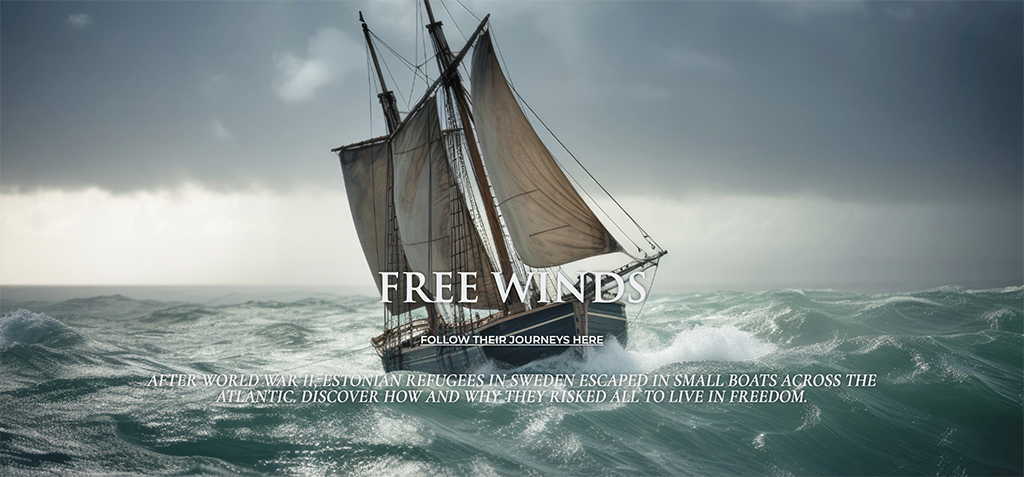Digital exhibition at Vabamu highlights the remarkable journeys of Estonia’s modern-day Viking ships
“Free Winds” is a new online exhibition opening this month at Vabamu Museum of Occupations and Freedom in Tallinn. Curated by Lisa Trei, a master’s student at Tallinn University, the exhibition reveals how thousands of Estonian refugees secretly fled from Sweden in the late 1940s and sailed in old, battered boats across the Atlantic Ocean to freedom.
The refugees had just escaped from Estonia. In autumn 1944, as the Nazi German occupation collapsed and the Soviet Army advanced across the Baltic States during World War II, 26,000 Estonians crowded into small boats and fled to Sweden. Another 50,000 escaped, mostly to Germany. Estonians thought they were safe in Sweden but soon the Soviet Union began pressuring the Swedish government to send “its citizens” back. Having survived the 1940-41 Year of Terror when Soviets imprisoned, murdered, and deported 20,000 Estonians, the refugees had no illusions about what would happen if they returned home.

In the immediate post-war period, it was time-consuming and expensive for the refugees to emigrate legally. Preferring to control their own destinies, Estonians pooled their meagre savings, bought and repaired old boats, and quietly sailed them as far away as possible from the Soviet Union. “Free Winds” tells the stories of these brave men, women, and children.
According to maritime historian Jüri Vendla, about 47 ships left Sweden between 1945 and 1951. At least 17 vessels made it to the United States, 11 reached Canada, 7 sailed to Argentina, 2 landed in Brazil, and 3 reached South Africa. Estonians organized most of the unsanctioned voyages, but Latvians and other nationalities also captained ships. Several boats were forced to end their journeys early. Others probably sank or may have been seized by Soviet ships patrolling in European waters, but since the voyages were planned in secret, accurate figures are unknown.
The popular press dubbed the vessels “Viking boats” because they came from Sweden and because, thanks to their skilful crews, most made it across the Atlantic. “No one, except the Vikings, has come in such a small boat,” an astonished Canadian official exclaimed when the Astrid landed in Quebec in 1948 with 29 people on board.
The journeys were difficult and dangerous. The ramshackle boats sailed without modern communication equipment and crews spent days scanning the seas in search of patrolling Soviet ships and sea mines. Captains navigated storms in the treacherous Bay of Biscay near Spain and the Sargasso Sea in the Atlantic using only antiquated maps and sextants. With diesel fuel in short supply, the boats unfurled their sails and took advantage of the Atlantic trade winds that carried Christopher Columbus to the Americas 450 years earlier.
When they landed, the refugees requested asylum. Many waited for months in detention, but nearly all were allowed to stay. The arrival of the Viking boats pushed the governments of the United States and Canada, where most of the refugees landed, to make it possible to immigrate legally and many more followed on official voyages.
One of the goals of “Free Winds” is to advance Jüri Vendla’s research in his book Unustatud merereisid. Eestlaste hulljulged põgenemisreisid üle Atlandi 1940. aastate teisel poolel (Forgotten Sea Journeys: The daring escapes of Estonians across the Atlantic in the late 1940s). This is the only comprehensive account of the Viking ships. When the book was published in 2010, Mr Vendla noted that Soviet censorship had suppressed this period of Estonian history and further research was warranted.
Thanks to the digitization of Estonian and foreign newspapers during the last decade, “Free Winds” includes new details about many of the boats—but the record is incomplete. Please contact me at lisa.trei@vabamu.ee if you have additional information, comments, or corrections. I am interested in adding to the passenger lists, obtaining photographs, and learning more about the voyages that are only briefly mentioned.
I am honoured to curate “Free Winds” through a partnership with Vabamu museum, where I served as a Fulbright Specialist in spring 2024. Many people have supported the project, but special thanks must be extended to the helpful staff at Vabamu, especially Ede Schank Tamkivi, who graciously agreed to host Free Winds on Vabamu’s NoVa (Noorte Vabamu) platform. Graphic designers Franka and Anni Vakkum conceived the look of “Free Winds,” and it reflects their skilled artistry and understanding of Estonian history. Inga Solman, a software developer at Civitta, expertly and patiently brought the website to life.
Thank you also to Liina Viies and Kadri Linnas from the Estonian Ministry of Foreign Affairs who arranged for graduate student Maja Soomägi to work at Vabamu as a summer intern. Thanks to Maja’s language skills, “Free Winds,” currently in English and Estonian, will also be available in Swedish. Coincidentally, Maja is a descendent of Theodor Wompa, captain of the Gladstone, and was able to provide new information about the ship and its passengers. I look forward to additional insights from individuals who can contribute to this remarkable period of Estonian history.
Refugees today continue to brave the seas, often in unseaworthy and dangerously overcrowded vessels. “Free Winds” is dedicated to all people who have been forced to flee their homes in search of safety and security. It especially honours the refugees of Ukraine who, since the 2022 full-scale Russian invasion of their homeland, have found safe haven in free Estonia, Latvia, and Lithuania.
View the exhibition: Free Winds – Free Winds exhibition (vabamu.ee)







